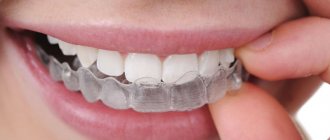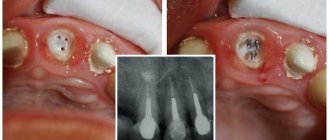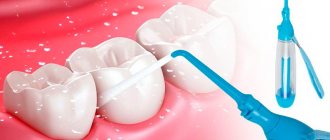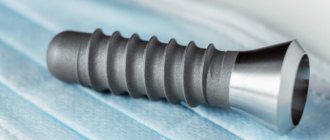Is it possible for an implant to fall out and how often does it happen: probable causes and consequences
Article navigation
- How to identify the problem
- Causes
- - doctor's actions
- - patient actions
- Rejection after a few years
- Assessment and diagnosis
- Methods for solving the problem
Question for a specialist
Losing a dental implant is a fairly rare situation. This can happen either within 2–3 weeks after surgery to install the implant, or after several years of use for various reasons. These include medical errors or improper actions by the patient. In this case, it is possible to lose fixation not of the metal rod itself, but of its components - the gum former or temporary plug. What symptoms indicate a complication of implantation, for what reasons this happens, what to do if a dental implant falls out, we will discuss in detail in this article.
What signs can be used to determine that the implant has lost stability and fixation?
Even before visiting a doctor and carrying out a professional diagnosis, several clear signs can help you understand that something is wrong with the installed implants. The following symptoms indicate this:
- change in the color of the gums at the site where the rods are installed: redness, appearance of a bluish tint,
- the formation of slight swelling around the implants,
- loose fit of the mucous membrane to the artificial structure, it moves slightly away from the crowns,
- the appearance of not strong, but noticeable pain when chewing, pressing on the implant and the mucous membrane around it,
- development of slight bleeding from the hole surrounding the implant,
- the occurrence of an unpleasant odor, the source of which is the implant area,
- increase in body temperature to 38–39°C,
- purulent discharge from the tissues surrounding the implant,
- loss of stability of the implant, obvious mobility of itself or its individual elements, mobility of the prosthesis.
%akc54%
All these symptoms, both together and separately, indicate a developing pathology and require immediate consultation with a doctor. In the postoperative period, in the first few weeks, this should not be attributed to tissue injury. The chances of a favorable outcome and the ability to save the implant are greater if you pay attention to even minor manifestations.
Possible reasons for the loss of artificial structures
Implant surgery is a strict surgical protocol with step-by-step procedures. Its scrupulous observance, both during preparation and direct surgical intervention, and during the rehabilitation period, is mandatory. If the methodology and requirements are violated, the doctor makes mistakes and the patient fails to follow recommendations, complications arise.
When a dental implant falls out, this indicates an extreme degree of complication, which is preceded by mucositis and peri-implantitis - first superficial, and later deep inflammation of the tissues around the implant. These, in turn, are caused by the accumulation of plaque on the surface of the rod and other reasons.
The reasons are identified, which are based on the doctor’s mistakes, and those for which the patient is responsible. We can talk about the wrong actions of a specialist if the implant is rejected in the first few weeks after its installation. In this case, unscrupulous doctors may tell their patients that their body simply “did not accept” the foreign body. However, this should be questioned, since modern methods of preparing patients and performing surgery almost eliminate this situation. Rejection of structures occurs, according to official data[1], in 2–5% of cases.
In addition to the implant itself, its individual elements can lose stability - the gum former or the plug (used in a two-stage implantation protocol). They can get unscrewed or fall out due to a mismatch with the size and shape of the implant or a loose connection. It is also possible for the crown to detach from the implant shaft or for the screw method to loosen due to unwinding. For this reason, cement connection of implants and prostheses is preferable.
What to do if you get loose
Of course, it is very important to seek advice from your doctor as soon as possible. Only a professional will be able to determine why the pin is moving, conduct a complete sanitation of the oral cavity and prescribe a comprehensive examination. After removal, antibacterial treatment will be carried out, after which it will be possible to talk about the etiology of this pathology. If there is a doctor's error or non-compliance with the rules of care, a repeat operation may be prescribed.
If engraftment fails due to the small volume of bone tissue, then bone augmentation will most likely be required. If chronic disorders or oncology were discovered, then another installation will have to be abandoned. An alternative may be removable prosthetics.
Often, symptoms that appear, for example, the smell of rot or movement, can be eliminated by carrying out the following manipulations: screwing in the pin plug, thoroughly cleaning all external elements. In some cases, the dentist is able to save the implant. The most important recommendation is a timely visit to a medical facility at the slightest suspicion of loosening.
Implant rejection due to doctor's actions
The positive outcome of the operation in the first stages - during the period of preparation and surgical intervention - depends 90% on the professionalism and experience of the implantologist. That is why the responsible choice of a specialist is so important.
What to pay attention to when coming for a consultation with a particular specialist, read the material “How to choose a doctor and clinic?”
What mistakes can a doctor make at different stages of implantation, and this will lead to tissue inflammation and rejection of the structure:
- during preparation: assessment of the condition of bone tissue and the oral cavity based on an orthopantomogram (OPTG), rather than a more detailed computed tomography (CT), which does not allow one to fully verify the safety of implantation in a particular area of the bone,
- incomplete collection of the patient's medical history, lack of data on chronic diseases and contraindications for implantation, absolute or relative. Special conditions are not taken into account, such as periods of menstruation or menopause in women, long-term smoking and alcohol intake before surgery,
- during planning: illiterate choice of place for the implant, its location in too thin bone, close to the roots of living teeth,
- during a surgical operation: deviation from the rules of sterility, entry of bacteria, saliva into the hole, use of implants not intended for the protocol used, overheating of the bone during drilling, nerve damage, leaky connection of implant parts, incorrect positioning of the rod in the bone, excessive deepening of the implant or creating a hole that is too wide for him,
- during the period of prosthetics: irregularities in the manufacture of the prosthesis, uneven load distribution, overload of the structure at certain points, implantation of only one row without taking into account the work of the opposite one, cement getting into the socket, etc.
Treatment tactics
The doctor’s actions when a patient complains of weak implant fixation depend on the nuances of the clinical situation.
If the problem is twisting or falling out of the gum former, a specialist can take the following actions:
- in case of too deep implantation , removal of excess bone tissue;
- in the presence of an inflammatory process , remove the structure and carry out antibacterial therapy;
- if there are no additional defects , re-screw in the former or replace it with a new one.
When unscrewing the crown installed on the implant, the specialist will replace the cement fixation with a screw one.
The situation with a titanium rod unwinding and falling out of the gums is quite rare. The reason for this phenomenon may be unqualified actions of the implantologist, poor quality of the design, or violation by the patient of the rules for using and caring for an artificial tooth.
Twisting of the rod in most cases is accompanied by the development of an inflammatory process, which requires removal of the structure and treatment of the affected area of the jaw row.
Fixation of a new implant is possible only after eliminating inflammation of the gum and bone tissue, and performing a sinus lift procedure if the need arises.
What role does the patient's actions play?
A competently performed operation by a doctor does not guarantee the absence of complications, since during the rehabilitation period most of the responsibility for the condition of structures and the oral cavity falls on the shoulders of the patient. The engraftment of the implant and its further operation depend on how he follows the surgeon’s recommendations and monitors hygiene.
“In my situation, after dental implantation, the consequences were unpredictable. I put in a tooth, before this I walked for 15 years without it and nothing happened, but the doctors finally persuaded me. They said: “You will forget about the problem for the rest of your life.” But as a result, I only lived with the new tooth for 5 years. First, my gums hurt, then it became loose, and the doctor pulled it out for me directly with my hands. They pulled it out and threw it away along with the money I spent on it.”
eskrei, review from otzovik.com
Why do implants fall out? Moreover, a situation is possible when the crown simply falls out due to loosening of the fastening, and it happens that the implant with the pin falls out, that is, the whole thing. Complications in the form of peri-implantitis and implant rejection are possible under the following circumstances:
- unwillingness or inability to give up bad habits during the rehabilitation period: smoking and drinking alcohol increase the risk of rejection,
- exceeding the permissible load on the implant: this is possible both at the beginning, when the patient begins to eat solid foods ahead of time, and after, when the implant has taken root and, having gotten used to the new teeth, the patient forgets about the ban on eating too hard foods, gnawing seeds and nuts,
- ignoring recommendations for taking certain medications during the period of osseointegration,
- the patient does not regularly and carefully monitor artificial structures and does not take care of the oral cavity, which is a consequence of the deposition of bacterial plaque and the appearance of inflammation. With the appearance of tartar, the situation worsens and over time affects the bone structures,
For information on how to properly care for implants and dentures installed on them, read the article on the website “Care for the oral cavity and dentures after implantation.”
Assessment and diagnosis of complications that have arisen
After the first symptoms are detected, professional diagnostic methods make it possible to reliably determine the cause and depth of the pathological process. For this purpose, radiography or computed tomography is used. They allow you to assess the condition of the bone tissue at the time when the implants fell out. A year after installation, the picture will be different than after one month of wearing implants. After diagnosis using these methods, the doctor gives his assessment and offers options for solving the problem.
Features of the body
The dental implantation procedure has a large number of contraindications, and if identified, the specialist will recommend methods to eliminate them or suggest another way to restore the missing tooth.
However, there are situations when a deterioration in health occurs when the artificial rod is already implanted into the bone tissue of the oral cavity or the pathological factor was not detected in a timely manner.
Implant loss can occur as a result of the development of the following conditions in the human body:
- diabetes;
- blood clotting disorder;
- the formation of benign or malignant neoplasms;
- pathologies in the functioning of the central nervous system;
- suppression of the body's immune function;
- systemic disorders of the connective tissue structure;
- susceptibility to allergic reactions, including to the material from which the artificial root is made;
- exacerbation of chronic diseases of the oral cavity affecting the condition of bone tissue.
Among dental conditions that can cause instability and loss of an artificial tooth, experts note chronic periodontitis, deformation and loss of bone tissue, and various malocclusion pathologies.
Loosening and loss of the dental system can also be caused by mechanical injuries to the maxillofacial apparatus received as a result of accidents, certain types of sports - football, boxing and other types of wrestling.











